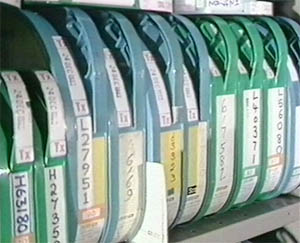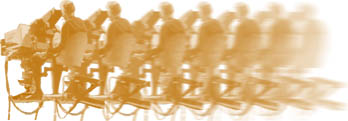This isn’t really about Tech Ops, and is the result of going to the BFI to watch a programme of vintage BBC Christmas trails. I had contributed some of them, but others that I’d made were also shown – some I hadn’t seen for more than 30 years. A bit weird. There were, I must point out, a large majority that I hadn’t made.
Of course tech ops people were much involved in the process of making trails in the 70s to 90s, and VT even more so. One of the lesser (much lesser) jobs of cameramen in those days was to work in Pres A, where a large part of the day was spent pointing at black and white lettered captions for lower third supers etc on trails. These were on black roller paper placed on black metal boards and held on by magnetic rubber strips – the same ones used for isobars on the weather boards right next to them. Various panning and revealing techniques were used for menus, top and tails. An undemanding task but necessary in the days before character generators.
Meanwhile in the gallery a sound supervisor would mix a voice over onto the already edited backing track. Actually most of the time the v/o was added live in the evening’s transmission session, and sometimes via a complex track relaying session using the pips from TIM and much swearing. This was for trails going out after everyone in Pres A had gone home.
The camera and sound crews worked the famous AP shift – 1000-2200, Monday, Wednesday, Saturday, Sunday, Tuesday, Thursday, Friday. For weeks or months ahead you could know what days and hours you were working. This was in marked contrast to work in other areas of the building which was completely irregular hours.
++++++++++++++++++++++++++
Anyway – The Christmas Promotions Campaign, or any other really. These were generally New Year, Spring, Autumn and Christmas, but specials also happened. Eastenders was a major happening in 1986. I was a BBC Presentation producer from the late 70s to the early 90s.
Given that each campaign happened to the same schedule every year, staff could be allocated well ahead, but BBC promotions ran a tight ship, and releasing staff from the usual treadmill was often a problem. A Christmas campaign needed two producers (BBC1 and 2) one assistant producer and two PAs. The juniors and PAs were often attachees, which tended to put more pressure on the producers.
Early on, the Promotions Editor, Pat Hubbard, and the Pres senior graphics designer, Oliver Elmes, would discuss graphics styles – something which always seemed to involve much shouting – I don’t know why. The producers might or might not have an input 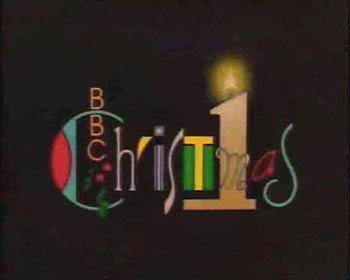 depending on their experience and relationship with Pat. The extended trail tail into a candle as the Christmas symbol (ident) in 1987 was my idea. The graphics team’s job was mostly to provide an opening 7″ animation with music, a lower thirds font style, and a tail. Various extras were also needed. What they actually put in to the animations was to a large extent up to them, with final approval by Pat and the producers. They, like us, would use the latest technology they could find and afford.
depending on their experience and relationship with Pat. The extended trail tail into a candle as the Christmas symbol (ident) in 1987 was my idea. The graphics team’s job was mostly to provide an opening 7″ animation with music, a lower thirds font style, and a tail. Various extras were also needed. What they actually put in to the animations was to a large extent up to them, with final approval by Pat and the producers. They, like us, would use the latest technology they could find and afford.
The campaign would start at the beginning of November, by which time an office had hopefully have been found for the team, often a bit of a problem in itself. Television Centre was full and busy. The team would need to know what they were going to promote, and that was not only secret but endlessly changing. In those days of three then four channels what mattered was beating ITV in the ratings and that was done by having the right programmes in the right place. The producers would be given provisional schedules under conditions of “don’t tell”, but they’d immediately have to tell their team otherwise nothing would happen.
Meanwhile the PAs would start work on all the background necessities. Amongst other things large numbers of captions would be needed. In the early days these were on roller paper and had to be checked and filed, in later years a list would go to the character generator operators. PAs would also book voice over people. We had a regular stable for a long time, with Ray Moore and John Braben at the top of the list. They would be booked for sessions recording BBC1 trails, but BBC2 trails were traditionally voiced by the staff continuity announcers. Ray was always my favourite – no-one could beat his version of “Programmes for Saturday Night on BBC1”. Ray maintained his voice with Park Drive full strength no filter cigarettes and a glass of Tantine (BBC red plonk) when we went down to the bar during breaks. I used to say “those will kill you, Ray” and sadly one day they did. In the late 80s Alan Dedicoat, then a Radio 2 continuity announcer, was first booked by my wife Pauline, and has been at the top of his trade ever since. His voice is on the trail at the bottom of the page – and on the Lottery, Strictly Come Dancing, and much more.
The biggest Christmas secret was the BBC 1 film and its transmission time. In those days – no film channels and a gap of five years between the cinema showing and the first tv showing – it would be the centrepiece of the schedule. If you were running Raiders of the Lost Ark or whatever, that was a real event. 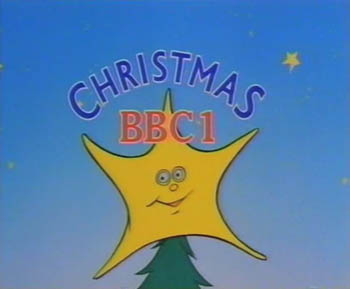 One year I was so sworn to secrecy I couldn’t tell one of my bosses, which really annoyed her. I think it was Gone With The Wind, which I didn’t think would be that great a viewer grabber and which in the end wasn’t shown on Christmas Day.
One year I was so sworn to secrecy I couldn’t tell one of my bosses, which really annoyed her. I think it was Gone With The Wind, which I didn’t think would be that great a viewer grabber and which in the end wasn’t shown on Christmas Day.
Once the team had the list they’d start ringing up programmes to get material. Many of the big LE shows were recorded quite early on, and would often be finished by mid-November, but some shows would be far from finished at that point. In several cases when on BBC 2 I rang productions that didn’t even know they were on at Christmas and they got a rude shock. Alan Yentob didn’t always communicate that much. Having got hold of spool numbers we’d start to watch what we could.
A large amount of VT viewing time was booked for Christmas.We had a single 2″ machine, later 1″, and we’d sit and watch for hours making first tape time and later timecode notes as we went. There were no VHSs or DVDs, the only copy was the 2″ master, which would tend to live on the Christmas promotions trolley in the basement. Most of the feature films were transmitted from 35mm telecine and not transferred to VT, and we’d generally only be allowed the first two reels – don’t know why – from which we’d have to transfer parts ourselves in a session using a TK machine on the second floor playing to a 2″ VT machine in the basement. We could order up the cinema trailer, and that might provide good material if it was in good condition and not covered in graphics. Some programmes were on 16mm film and we had to make various arrangements depending on the state of the programme at the time.
Some material just wasn’t going to be available in time, so we’d have to find something else. An interesting morning in a toy shop in Covent Garden filming with Paul Daniels, or a shot of a Beretta and a rose in Pres A with appropriate music for The Godfather. I walked the Beretta from the armoury to Pres A in a paper bag.
As November progressed we’d find a lot of editing sessions coming our way, and often we didn’t yet have the material to fill them. Nevertheless, editing was precious in the days of 2″ VT, so we’d make a start on what would soon become a 12 hour day, 7 days a week schedule. Editing on the machines of those days was cumbersome and slow, and there was nothing else. The tapes were large and heavy, but also rather vulnerable. The sound ran along the top edge of the tape, and the roll had to lay smooth for its whole length, so when finished with, it needed to be run down to the end and back. On an Ampex VR1200 that was a long slow process, and was wasted time during which we just had to sit and wait.
We’d put the original programmes or our TK transfers on the play-in machine, and a new tape (called the editec after the original electronic editing system) on the record machine. Clips for the trail would be cut together one after the other. With two machines vision 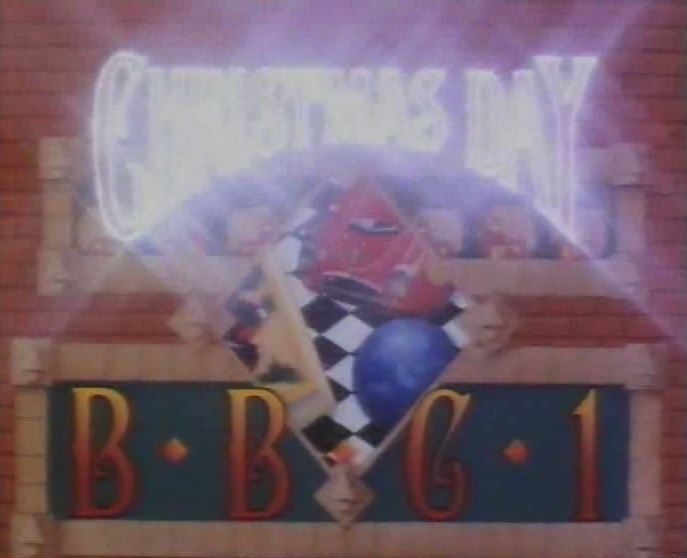 could only be cut together. Sound could be mixed, but in order to do so it had to be copied off to a quarter inch audio recorder. To make the edit, the ¼ inch machine would be cued back the same 10 seconds as the other machines. The editor would start all three together, and after checking that the ¼ inch was in sync, start recording the matching sound from it, mixing through to the incoming when appropriate. Each edit would take maybe ten minutes, so a compilation trail with perhaps 20 edits would take a fair amount of time. When complete it would be a set of clips without the animations, graphics supers or voice over. Sound might have music stripped through or use the sound from individual programme if familiar. Editing sessions would last 4, 8 or 12 hours. In the early days VT wasn’t a very friendly place for presentation people – a fair number of editors felt that a Pres session was demeaning to their art, even though it would generally be one of the most demanding. That world gradually went away during the 80s.
could only be cut together. Sound could be mixed, but in order to do so it had to be copied off to a quarter inch audio recorder. To make the edit, the ¼ inch machine would be cued back the same 10 seconds as the other machines. The editor would start all three together, and after checking that the ¼ inch was in sync, start recording the matching sound from it, mixing through to the incoming when appropriate. Each edit would take maybe ten minutes, so a compilation trail with perhaps 20 edits would take a fair amount of time. When complete it would be a set of clips without the animations, graphics supers or voice over. Sound might have music stripped through or use the sound from individual programme if familiar. Editing sessions would last 4, 8 or 12 hours. In the early days VT wasn’t a very friendly place for presentation people – a fair number of editors felt that a Pres session was demeaning to their art, even though it would generally be one of the most demanding. That world gradually went away during the 80s.
Each week a trail sheet was published by Pat Hubbard, and the Christmas trails would first appear in early December. Normally the highlights would come first – films, starring the big Christmas Day epic, and a more general trail with clips from many programmes. Some years we’d do a “Happy Christmas” trail with as many BBC stars of Christmas as possible. We didn’t do featurettes of the type done in more recent years, such as the sprout of 2015. Bums on seats were what was required, so we stuck to selling the programmes, which were generally the best the BBC could offer. During the 90s the BBC seemed to forget all that and the cost/benefit ratio seems to have gone down ever since.
The Presentation Promotions department lived on the fifth floor of Television Centre in a side corridor shared with the weather office and Esme’s tea bar. Esme was a loud character who would sometime refuse to serve people if she didn’t like them. The rest of the fifth floor was drama plays, and many well known dramatic people worked there and shared the tea bar. The technical heart of promotions was Presentation Studio A . It was mostly our studio to use as we pleased, provided we made sure the weather got on the air, as the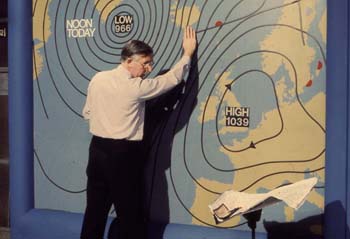 boards were down the side of the studio. The day was divided into sessions – morning, afternoon, evening – with the first two making trails and the evening transmitting the BBC1 trails. Like outside broadcasts but no other department the production team operated the vision mixer. This originally was a standard issue BBC mixer as used in the studios downstairs. This had evolved down the years from the days when the studio gallery only had two monitors, on air and preview. By the late seventies is wasn’t the tool for the job, and various boxes were added to customise it for our use. In 1982 the whole studio was stripped out and engineer Peter Weitzel worked with us to give us what we needed, centred on the first Grass Valley 300 mixer (switcher) in the UK. This allowed us a freedom that was the envy of sport, and wasn’t superseded until some years later when multi-machine editing became more plentiful and cheaper. We also had the first Quantel Stills Store. Sometimes putting a trail together in Pres A would take three of us hanging over each other. An understanding of what the technology could do was a major advantage for a Pres producer.
boards were down the side of the studio. The day was divided into sessions – morning, afternoon, evening – with the first two making trails and the evening transmitting the BBC1 trails. Like outside broadcasts but no other department the production team operated the vision mixer. This originally was a standard issue BBC mixer as used in the studios downstairs. This had evolved down the years from the days when the studio gallery only had two monitors, on air and preview. By the late seventies is wasn’t the tool for the job, and various boxes were added to customise it for our use. In 1982 the whole studio was stripped out and engineer Peter Weitzel worked with us to give us what we needed, centred on the first Grass Valley 300 mixer (switcher) in the UK. This allowed us a freedom that was the envy of sport, and wasn’t superseded until some years later when multi-machine editing became more plentiful and cheaper. We also had the first Quantel Stills Store. Sometimes putting a trail together in Pres A would take three of us hanging over each other. An understanding of what the technology could do was a major advantage for a Pres producer.
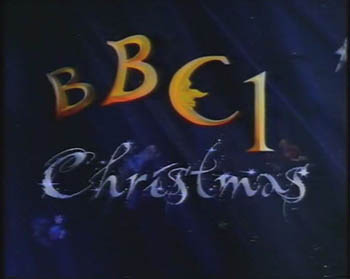 After some editing, the Christmas team would be allocated studio sessions in Pres A, usually three hours long. We’d add the film animations, lower third supers and voice over, making various versions – next week, tomorrow, etc as required. Over the weeks we’d gradually move to trails for single programmes and menus for the actual days of Christmas. The Christmas symbol, these days called an ident, wouldn’t appear until Christmas Eve. In the early days this was a mechanical model – two in fact, one for each channel. these were set up in Pres B, thus taking over that studio for three days. The models were a joint venture between Pat Hubbard, Oliver Elmes and Bill Marshall, who ran the mechanical workshop. Bill enjoyed his yearly trip away from maintaining camera mounts etc. In later years we had to move out of Pres B, but other facilities weren’t terribly available, so various not-totally-satisfactory solutions were used for a number of years.
After some editing, the Christmas team would be allocated studio sessions in Pres A, usually three hours long. We’d add the film animations, lower third supers and voice over, making various versions – next week, tomorrow, etc as required. Over the weeks we’d gradually move to trails for single programmes and menus for the actual days of Christmas. The Christmas symbol, these days called an ident, wouldn’t appear until Christmas Eve. In the early days this was a mechanical model – two in fact, one for each channel. these were set up in Pres B, thus taking over that studio for three days. The models were a joint venture between Pat Hubbard, Oliver Elmes and Bill Marshall, who ran the mechanical workshop. Bill enjoyed his yearly trip away from maintaining camera mounts etc. In later years we had to move out of Pres B, but other facilities weren’t terribly available, so various not-totally-satisfactory solutions were used for a number of years.
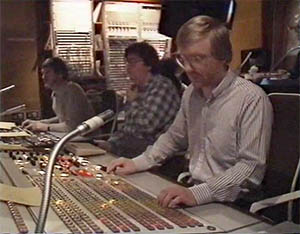 By early December the Christmas promotions team would be working most days trying to keep up with the list on the trail sheet – watching, logging, writing, editing, studio. Home life was forgotten, and sleep didn’t last long enough. Sometimes, when you’d been in VT all day and the evening was wearing on towards the end, Pat Hubbard would appear with a bottle of cold white wine. This was very welcome but generally slowed things down when they really shouldn’t have been. Usually the last Christmas trails were made on Christmas Eve, and if you were lucky you could have a leisurely lunch at the end of six weeks of non-stop work. Christmas Day would pass in a daze, to the sound of your work going out endlessly –
By early December the Christmas promotions team would be working most days trying to keep up with the list on the trail sheet – watching, logging, writing, editing, studio. Home life was forgotten, and sleep didn’t last long enough. Sometimes, when you’d been in VT all day and the evening was wearing on towards the end, Pat Hubbard would appear with a bottle of cold white wine. This was very welcome but generally slowed things down when they really shouldn’t have been. Usually the last Christmas trails were made on Christmas Eve, and if you were lucky you could have a leisurely lunch at the end of six weeks of non-stop work. Christmas Day would pass in a daze, to the sound of your work going out endlessly –
“Christmas Entertainment on BBC1”
BTTF
No Description
Breakfast Time BBCtv Christmas Preparations 1983
A film for BBC Breakfast Time looking behind the scenes in 1983
Bernard Newnham 15th December 2015

